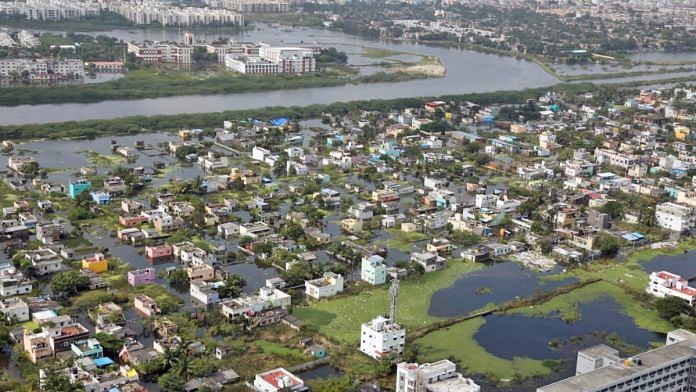
New Delhi: A new report on the impact of climate change in India has highlighted that the country could see hotter summers, changed rainfall patterns, flooding, and loss of soil fertility by 2057 even if the world follows the path of a moderate reduction in emissions. And if it continues down the path of high emissions, the average annual maximum temperature in India could increase by 1.5 degrees Celsius (°C) by 2047.
The new report by Azim Premji University , published on 17 November, uses two Intergovernmental Panel on Climate Change (IPCC) scenarios—“moderate emissions and adaptation” (SSP2-4.5) and “high emissions with heavy fossil fuel reliance” (SSP5-8.5)—to extrapolate “how extreme weather events, like heat waves, droughts, and intense rainfall, could affect communities, agriculture, and natural resources”.

The report, titled ‘Navigating India’s Climate Future: Climate Projections for India (2021-2040)’, is targeted at climate stakeholders, including government officials and activists, to support climate resilience and adaptation efforts. “India is one of the global hotspots for climate change. With the majority of the population relying on agriculture and natural resources for survival, coupled with a high population density, they are acutely vulnerable to the impacts of climate change,” the report said.
Presenting the projections under the two scenarios, the report said that India will see a 1.5°C rise in its average annual maximum temperature by 2057 if the world undertakes a moderate reduction in emissions. However, if the world continues down its current path of high reliance on fossil fuels, this rise in temperature could occur a decade earlier, in 2047.
Under the SSP2-4.5, even with a moderate reduction in emissions, around 196 districts are expected to see an increase of at least 1°C in the summer average maximum temperature by 2043. The highest temperature increases are expected in north India’s Ladakh, Kashmir, and Uttarakhand, followed by the western Indian states of Rajasthan and Gujarat.
Under SSP5-8.5, a whopping 517 districts could see an increase of at least 1°C in the summer average maximum temperature, with 17 districts expected to see an increase of 1.5°C.
Furthermore, Rajasthan and Gujarat could see a lot more rainfall in general by 2043, while Arunachal Pradesh, Sikkim, and other parts of the northeast could see a deficit in their annual rainfall of up to 15 percent. Any change in the average maximum temperature will have consequences for human health, ecosystems, and the economy. The report said that the analysis of temperature and precipitation changes from 1986 to 2015 has already shown the accelerated warming across the country in the past three decades.
Any major changes could negatively impact the agrarian economy and food security in the country. Also Read: Emerging economies, excluding China, need $1 trillion in climate finance annually—new report at COP29 The report by Azim Premji University uses data from the IPCC called Coupled Model Intercomparison Project Phase 6 (CMIP6), which provides global models to forecast the effects of climate change and global warming on the world. The report has then synthesised this to a district level in India, and come up with a dataset and interactive map that shows exactly how each district will experience the effects of climate change.
In the section detailing changes in precipitation patterns, the report says that 70 percent of India’s total precipitation comes from the monsoon rains and any change in it could badly affect the country’s agriculture. An increase in rainfall can be expected to lead to a rise in climate-induced calamities, including flooding and landslides, especially in arid regions, like Gujarat, Ladakh, and Rajasthan. “Arid states such as Gujarat and Rajasthan exhibit a higher annual precipitation ranging from 20 to 40 percent under SSP2-4.
5 and a 20 to 50 percent change under SSP5-8.5,” it said. This will impact agriculture, which accounts for 15 percent of the Indian economy, it said.
In Haryana, for instance, ThePrint had earlier reported , farmers are already talking about switching to underground crops like turmeric and root vegetables—which can better withstand the heavy, unpredictable rainfall. Experts also noted that monsoons in northwest India have been growing more erratic for years. The report further projects drought-like scenarios in northeastern states such as Assam and Arunachal Pradesh, particularly affecting livelihoods of people dependent on rain-fed farming.
“In the low emission scenario, Devbhumi Dwarka district in Gujarat will see a 37 percent increase in precipitation while East Kameng district in Arunachal Pradesh is projected to see a 3 percent deficit rainfall.” The increased precipitation will also fuel social erosion, decreasing soil fertility and agricultural productivity. “This data empowers local authorities, policymakers, and community leaders to develop targeted strategies to safeguard lives and livelihoods,” the report added.
(Edited by Sanya Mathur) Also Read: India’s emissions could go up 4.6% by 2024-end, 50% chance world will breach 1.5°C limit by 2030 var ytflag = 0;var myListener = function() {document.
removeEventListener('mousemove', myListener, false);lazyloadmyframes();};document.addEventListener('mousemove', myListener, false);window.addEventListener('scroll', function() {if (ytflag == 0) {lazyloadmyframes();ytflag = 1;}});function lazyloadmyframes() {var ytv = document.
getElementsByClassName("klazyiframe");for (var i = 0; i < ytv.length; i++) {ytv[i].src = ytv[i].
getAttribute('data-src');}} Save my name, email, and website in this browser for the next time I comment. Δ document.getElementById( "ak_js_1" ).
setAttribute( "value", ( new Date() ).getTime() );.














